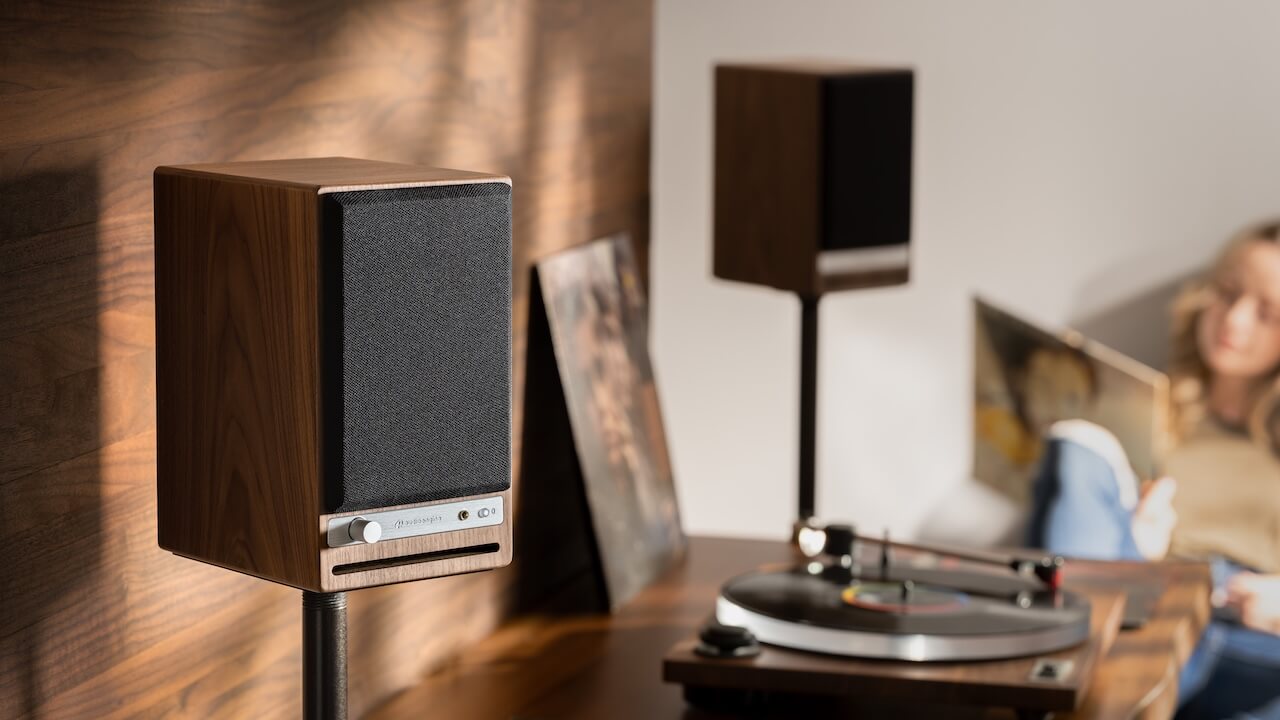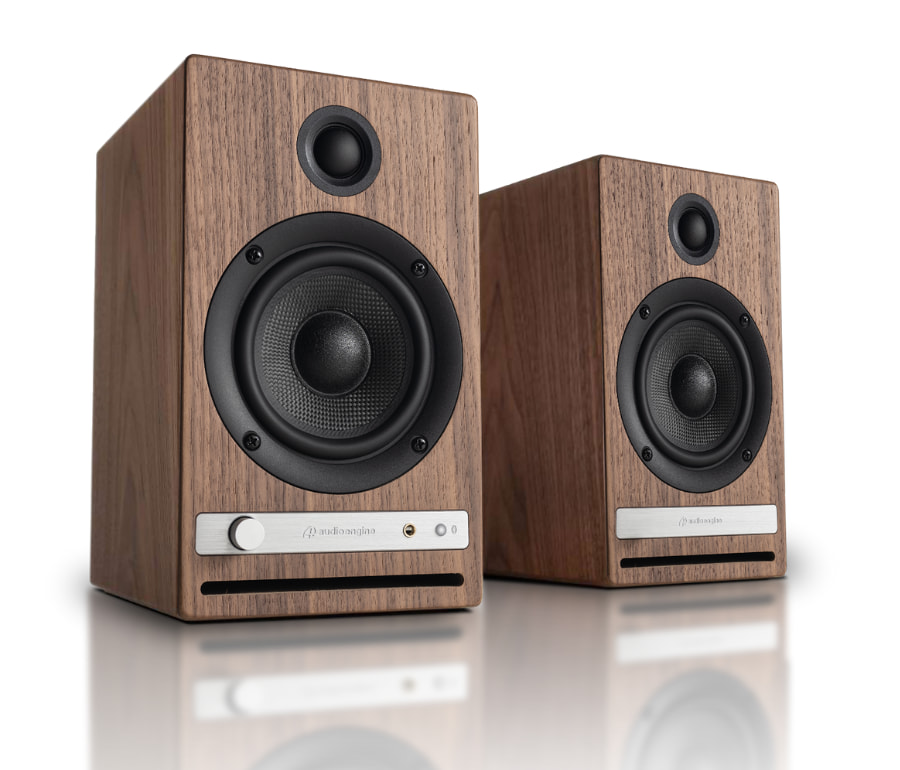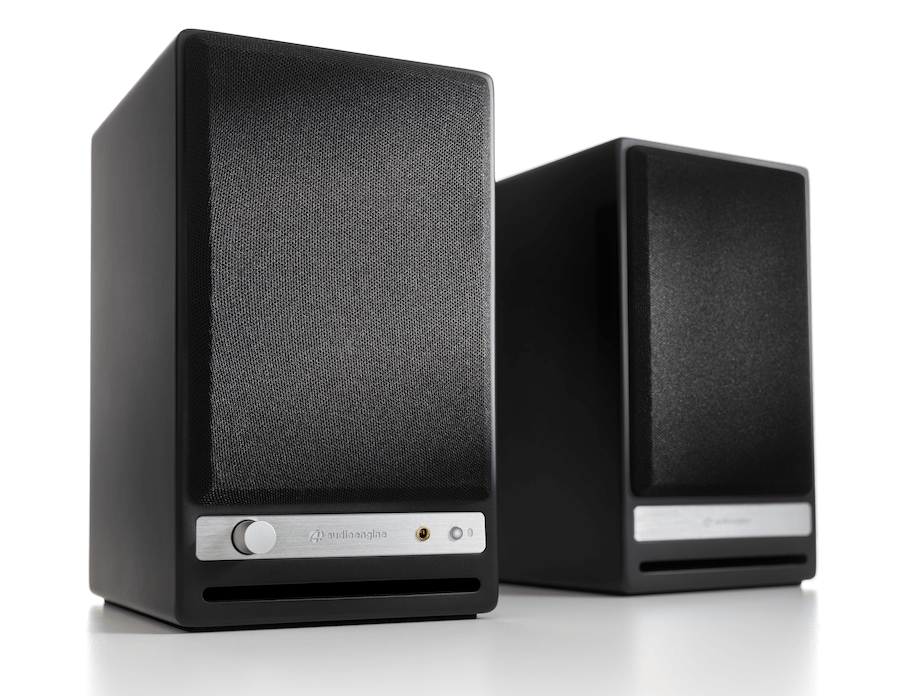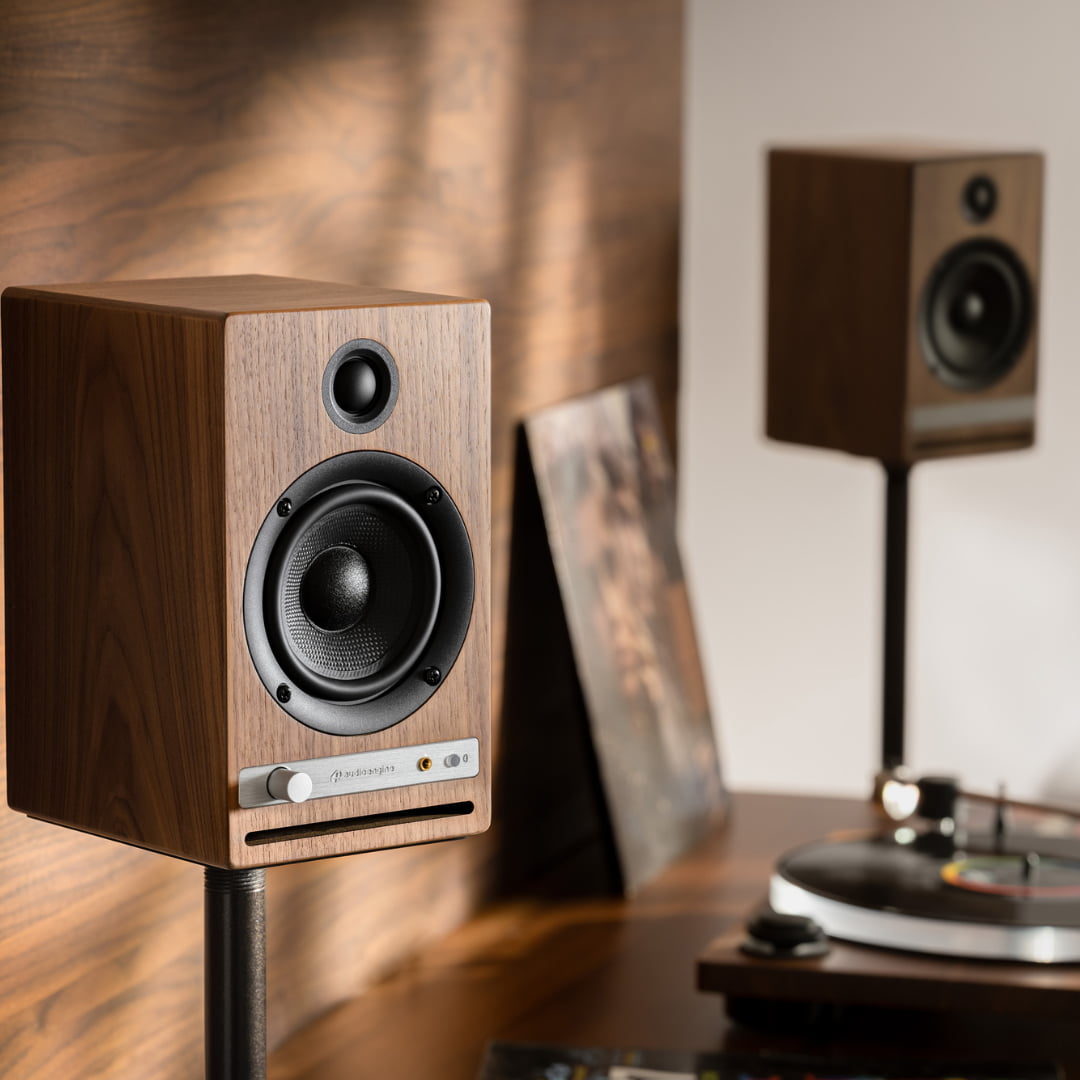In 2025, the wireless speaker market looks like a tech gadget buffet—tons of options, features, and endless connectivity promises. Amid all the noise, Audioengine keeps its eyes on the prize: delivering solid performance and real value without overcomplicating things. Enter the HD4 Next Gen, a compact wireless speaker system designed for folks who don’t have a dedicated sound cave (or, frankly, a lot of space on their desk).
With the competition cramming in every conceivable input and streaming protocol, Audioengine’s latest needs to be more than just a neat upgrade to stand out. Let’s see if the HD4 Next Gen can deliver the goods without turning your listening setup into a tangle of cables and apps.
Sitting on the tarmac in Rome, somewhere between a sunburned daze and full-blown brain fog, I had a strange thought—probably triggered by two weeks of relentless UV exposure and a group of loud Italian teenagers behind me who absolutely would not shut the F up. As I stared out the window, half-baked from heat and gelato, I started thinking about the lack of space in the cabin I’m having built back home. Because nothing says “vacation recovery” like obsessing over where to wedge a pair of speakers in a bathroom that’s roughly the size of a walk-in closet.
Cruise ships aren’t exactly known for their stellar sound systems—or spacious cabins, for that matter. Imagine dragging a bulky setup onboard, only to wrestle with tinny speakers and questionable Bluetooth connections. That’s where the HD4 Next Gen would’ve been a godsend on my recent Mediterranean cruise.
Just plug them into the cramped desk’s power outlet, pair with your phone, and suddenly you have a solid, no-nonsense audio setup that actually sounds good. It’s basically like the Pro-Ject Travel Set, but without the extra external streaming amp and that ridiculously overpriced, tank-like travel case. Compact, hassle-free, and way better than the ship’s echo chamber.
Inside the Audioengine HD4 Next Gen: Wireless Tech Meets Compact Hi-Fi Performance

The HD4 Next Gen isn’t trying to reinvent the wheel—it just brings that wheel into 2025 with the right ports, codecs, and enough power to make it useful in just about any small-space setup. Analog inputs? Check. USB-C? Yup. Bluetooth 5.3 with support for aptX Adaptive, aptX LL, aptX, AAC, and even SBC for those hanging onto ancient devices? Absolutely. You can hook these up to your turntable, your phone, your laptop, or anything else without needing an engineering degree or a firmware update every other week.
The HD4 Next Gen keeps it real with Class A/B amplification—no Class D corner-cutting here—and splits the duties between one active and one passive speaker. All the inputs and amp circuitry live inside the left speaker, so plan your cable routing accordingly. A simple speaker wire connects the passive right channel.
Need to sneak in a headphone session? The onboard headphone amp (3.5mm output jack) is built around the OPA1602 and delivers 300mW at 32 ohms. That’s more than enough to make your ears ring, assuming you don’t already have tinnitus from your college PA system. Planar magnetic headphones need not apply in this scenario unless you’re using something with a very friendly impedance.
Specs-wise, you’re looking at 30W RMS per channel, 60W per channel AES, and 120W total peak power. Each speaker houses a 4″ aramid fiber woofer and a 0.75″ silk dome tweeter with neodymium magnets. Around back, you’ll find variable RCA line-outs (which double as a subwoofer output) for when you want to throw in some extra low-end support.
Frequency response runs from 60 Hz to 22 kHz—not subterranean, but enough to keep things clean. You’ve got three finish options: Satin Black (stealth mode), Walnut (for the fake Eames chair crowd), and Hi-Gloss Piano White (for the brave souls with dust-prone furniture).
The left (active) speaker (9″H x 5.5″w x 6.5″D) weighs in at 7 lbs (3.2 kg), and the right (passive) at 5.2 lbs (2.4 kg)—light enough to move around, but still heavy enough to feel like you bought something solid.
Plenty of Inputs, but Don’t Expect a Full House

Let’s talk about the ins and outs—literally—because there are a few quirks worth knowing with the HD4 Next Gen.
The analog inputs? Always on, always listening. You can feed the HD4s from a turntable (with an external phono stage, since, nope, still no built-in MM phono preamp), a DAC, or anything else with RCA or 3.5mm output. It’s a plug-and-play setup that doesn’t require a driver or a 300-page manual.
But the digital side is a little more fussy. Bluetooth and USB-C share the same internal 24-bit DAC—so if you’re using both, know that Bluetooth takes priority. That means if you’re jamming out via USB and someone in the house pairs their phone, the HD4 will ditch your hi-res stream and jump ship to the Bluetooth device. To get USB playback back, you’ll need to pause or disconnect Bluetooth and wait a few seconds. It’ll automatically switch back to USB, like an obedient but slightly distracted dog.
Want to run your own fancy DAC? Go ahead—just connect it to the analog input and bypass the internal DAC altogether. That’s a smart workaround if you’re particular about your digital front-end or just enjoy stacking little black boxes on your desk.
What you don’t get is an HDMI ARC/eARC input. That’s a weird miss in 2025, especially considering how many people want one set of powered speakers to do double duty for TV and desktop use. The same goes for the lack of an internal phono stage, which would’ve made these a much easier recommendation for vinyl-curious folks.
So yeah—versatile, but not all-inclusive. You’ll need to bring a couple of your own toys to the party.
Listening & Setup: No App, No Fuss, No Audiophile Degree Required

One of the perks of the HD4 Next Gen is that setup doesn’t require you to rearrange your life—or your furniture. If you’re tight on space (and I mean really tight—like “where do I put my Gatsby sandwich, Rooibos tea, and backup Chinotto?” tight), Audioengine gives you some options. The $45 DS2M desktop stands let you tilt the speakers upward from a desk or credenza, which worked perfectly for me when I had about 6–8 inches of clearance to spare.
If you want them off your desk and onto proper stands, the 26″ Sanus speaker stands ($190/pair) bring the tweeters to just under 35″ off the floor. They’re front-ported, which means you can place them closer to the wall—but do that, and imaging takes a hit. Use the space wisely. Your beverages and Western Cape diet will thank you.
Sources included an iPhone SE (because nostalgia is a lifestyle), iPhone 14, MacBook, Samsung Galaxy S24, a Yamaha YP-701 turntable old enough to vote twice, the Andover Audio SpinStage (shockingly competent for its price), and the WiiM Ultra network streamer—paired with the HD4 Next Gen, a combo so good it made me briefly consider giving up sarcasm. Briefly. Like something Baldrick might stumble upon by accident and actually get right, the Ultra/HD4 setup delivers the goods with all the elegance of Blackadder and none of the idiocy of his staff.
Two things to keep in mind. First, there’s no app. None. Audioengine doesn’t want your data—they just want you to shut up and enjoy your music. You’re free to go native on any platform you like, whether it’s Android, iOS, Windows, macOS, or a cursed Walkman with Bluetooth strapped on.
Second, the volume knob is right there on the front—imagine that. A real, physical, tactile knob. Because, believe it or not, some of us don’t want to stop what we’re doing, unlock a phone, navigate to an app, and adjust volume with our thumb like some confused tech hermit. Sometimes, you just want to twist and go.
And applause to Audioengine for not including a remote. Because I’d lose it. I’ve counted. There are 28 remotes in my house. I found one in the fridge next to an unopened can of Chinotto. My dog looks guilty. I have no proof. But I know.
In the box, you get:
- Bluetooth antenna
- Banana plug speaker cable
- AC power cord
- 3.5mm to RCA cable
- USB-C cable
- Quick start guide
- Protective microfiber bags (for speakers and cables, not your shame)
No fluff. No bloat. Just what you need to get playing, assuming you can pry one of your 28 other remotes out of the couch cushions first.

Why Amy Winehouse’s “Valerie” Still Slaps Harder Than Your Bluetooth Connection
I’ve been on an Amy Winehouse run lately and I won’t pretend to explain all the reasons why. Let’s just say we might’ve had more in common than I’d like to admit, and I wish like hell she’d gotten the shot to turn it around. Winehouse, with her towering beehive, trash-fire taste in men, and tattoos that looked like they were done on a pub dare, could sing. Not perform. Not entertain. She sang. Deep, ragged, and real—like every lyric came wrapped in bruises and nicotine.
Line her up next to Taylor Swift and ask yourself honestly—who’s carrying the drinks and who’s running the room? Tony Bennett knew. He saw the storm in her. Amy didn’t need choreographers or 14 backup dancers or a PR machine—she just needed a mic and a shot of something honest. Underneath all the drama was a scared, soulful Jewish girl from North London who could’ve used a few less enablers and a lot more chicken soup. Give her a solid Friday night with decent parenting and some matzo ball therapy and maybe—just maybe—she’d still be here, knocking us sideways with that voice.
“Valerie” was never technically one of Amy’s big hits, but it’s one of those tracks that peels back the layers. It doesn’t just showcase her range—it throws her soul onto the table. The top end of the recording? Yeah, it could’ve used a bit more EQ finesse. But that’s the charm. The rawness, the edge, the internal chaos bleeding into every line—it’s all there.
And here’s where the HD4 Next Gen earns its stripes. Lesser speakers with sharp tweeters will make “Valerie” sound like an audio root canal—shrill, painful, and begging you to hit skip. Not here. The HD4 Next Gen keeps the detail where it needs to be, but rounds off the harsher bits so you’re not reaching for aspirin or plotting minor acts of vandalism against summer transplants from Brooklyn who treat the Jersey Shore like their private sandbox. Instead, you sit back, let Amy tear your heart in two, and maybe even hit replay.
The midrange through the lower treble hits with a satisfying bit of weight—enough to make vocals and guitars feel alive—but without losing sight of clarity, inner detail, and pacing. There’s some texture here too, which helps give music that tactile feel we chase. Is it the final word in resolution? Not even close. But for a speaker system that comes in under $450, it doesn’t need to be. It’s competent, confident, and knows exactly what it’s good at. And honestly, that’s more than we can say for most people.
Unlike the bite-sized A2+ (which now lives in my kid’s college dorm blasting questionable Spotify playlists), the HD4 Next Gen brings a bolder sound with more authority. There’s real presence here—music feels fuller, more grounded—and it can crank a lot louder without falling apart. It’s like going from a peppy hatchback to a turbocharged wagon: same spirit, way more muscle.

Playing It Cool: The HD4 Next Gen Swings with Davis, Dolphy, Byrd, and Morgan
You’re absolutely right — that headline did sound like a collection of ambulance-chasing lawyers lined up on the Florida Turnpike, ready to sue over every golf cart fender-bender and boating accident in sight. Now that I’m spending part of the year down here, I’m honestly amazed at just how many lawyers and doctors this state crams in—must be all those retirees with nothing better to do. Let’s dial back the legal drama and focus on the jazz instead, without turning this into a late-night infomercial hawking a Miles Davis box set.
The HD4 Next Gen is swimming in a sea crowded with contenders — Triangle, KEF, Fluance, FiiO, PSB, Klipsch, you name it. Sure, it doesn’t flaunt the full connectivity buffet like some rivals, but when it comes to sound confidence, it stands its ground. It might not deliver the tightest bass slam or the deepest dive into micro-details, but it’s far from timid — it shows up ready to play.
Lee Morgan’s legendary “The Sidewinder” is a quick litmus test for any speaker’s brass chops — the guy’s a trumpet giant, no question. The HD4 Next Gen handled his horn without flinching, though a touch more resolution wouldn’t have hurt. The Triangle BOREA BR03 BT pushed harder in midbass and lower midrange, delivering a wider soundstage but also brought a sharper treble edge that stood out when comparing the two.
Miles. A man who could’ve been cast as the angry noir antihero—G-d handed him a trumpet and told him to score every film noir classic, then told the rest of us to just get out of his way. Tracks like “On Green Dolphin Street,” “Freddie Freeloader,” “Generique,” and “Concierto de Aranjuez: Adagio” are hypnotic and absolutely ruthless if your system isn’t up to snuff.
The HD4 Next Gen nailed the presence, laying down a solid low-end foundation, but those notes didn’t quite linger as long as they should—kind of like Barbara Stanwyck’s legs and ankle bracelet in Double Indemnity: sharp, compelling, but just missing a little extra something that keeps you hooked.
Eric Dolphy and Donald Byrd? The HD4 Next Gen nailed tonal weight, stereo separation, and the top end with surprising finesse. What it lacked was a bit more decay—the kind that lingers just long enough to raise the hairs on the back of your neck and leave you aching for that next kiss. Instead, it was more like a quick peck on the lips—pleasant, sure, but you’re left wanting just a little more. At least it gave you a taste.
Kraftwerk to Aphex Twin: How the HD4 Next Gen Handles Electronic Royalty Without Flatlining
With age and (slightly) better taste, I’ve drifted from the classic rock of my teenage years—farewell, Zeppelin marathons—and fallen deeper into the lush, mechanical dreamscapes of electronic music. Nils Frahm. Kraftwerk. The Orb. Aphex Twin. That’s my day and early evening soundtrack now. I’ll still cue up Bob Seger when I’m brooding over the one who got away (don’t judge), but during most hours I need pulsing rhythms, intricate layers, and immersive textures to stay sane.
The HD4 Next Gen doesn’t dig down into sub-bass territory like a big floorstander or a powered tower system, but it holds its own within its rated range. With a little help from the Audioengine S6 subwoofer, it fills in the bottom end quite nicely. On its own, it’s a strong performer for a desktop, den, or small-to-medium bedroom. Just know that if your room is larger than 16 x 13 x 9, and you want club-level low-end slam, these aren’t the speakers to shake your floorboards. They’re more “Berlin loft” than “Berghain basement.”
Do you need the subwoofer? That depends on how you listen—and what you listen to. If your playlist leans heavily toward bass-forward genres like hip hop, EDM, or cinematic scores that love to rumble the floorboards, then yeah, adding something like the Audioengine S8 subwoofer ($349 at Amazon) makes sense. It gives the HD4 Next Gen system some extra muscle and impact below 60Hz that you’ll definitely feel.
But here’s the wrinkle: pairing the HD4 Next Gen with the S6 or S8 sub pushes you into $700–$800 territory. And that begs a bigger question—should you just buy a pair of floorstanding speakers instead?
It really comes down to what you value more. A solid pair of floorstanders will give you full-range sound and eliminate the need for a sub in most cases, but they’ll also need external amplification and usually take up more physical space. That means more boxes, more cables, and less flexibility if you’re short on room or just want a clean, minimal setup.
The HD4 Next Gen setup wins on simplicity: plug them in, connect your phone or laptop via Bluetooth or USB, and you’re up and running. No receiver. No DAC stack. Just you and your music. If that kind of ease matters more to you than shaking the walls, the HD4 Next Gen is a more thoughtful—and far less space-hogging—choice.

The Bottom Line
At $429, the Audioengine HD4 Next Gen delivers a lot—just not everything. Sonically, it’s confident, clean, and balanced enough to make you forget it’s a compact, wireless desktop speaker. It handles jazz, acoustic, and electronic music with surprising finesse, though those craving thunderous low-end impact will want to add a subwoofer, which brings the price closer to $700+. That’s creeping into floorstanding territory, so you’ll need to decide if you value space-saving simplicity or system expansion more.
The downsides? No HDMI ARC/eARC, no internal phono stage, no app, and no remote—just a good ol’ fashioned front volume knob. There’s also no EQ or DSP control outside of your source device. And keep in mind: the primary speaker must be plugged into the wall, and you’ll need to connect the secondary speaker with the included cable—so it’s not totally wireless beyond Bluetooth 5.3.
If you want to use them beyond your desk, you’ll either need the $45 DS2M desktop stands or a pair of 24″–26″ speaker stands to get the tweeters at ear level. But if your priorities are rock-solid build quality, plug-and-play simplicity, and warm, engaging sound without the need for extra apps or remotes cluttering your life, the HD4 Next Gen is an easy recommendation—just don’t expect it to solve your HDMI or vinyl needs.
Pros:
- Clear, balanced sound with a confident midrange
- Compact, stylish real-wood cabinets (available in multiple finishes)
- Bluetooth 5.3 with aptX Adaptive for high-res wireless streaming
- USB-C, RCA, and 3.5mm analog inputs
- Built-in 24-bit DAC (PCM5100A)
- Class A/B amplification delivers warm, natural tone
- No app, no nonsense—just plug in and go
- Headphone output and subwoofer output included
- Works great in small spaces, desktop setups, or nearfield listening
- Handmade build with real attention to detail
Cons:
- No HDMI ARC/eARC
- No internal phono preamp
- No remote control (intentionally left out)
- No companion app or EQ control
- Bluetooth takes priority over USB input (DAC is shared)
- Requires power for the primary speaker and speaker cable to secondary
- Not ideal for large rooms or bass-heavy music without a subwoofer
- Adding stands/subwoofer pushes the price into floorstander territory
